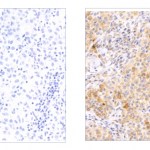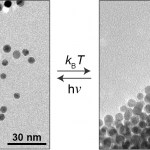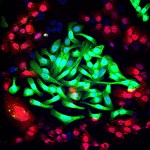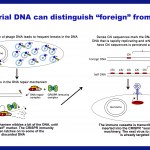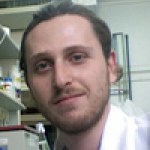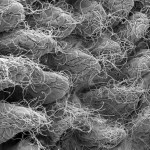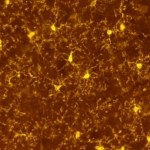Biomedical
Does the brain really operate like some kind of extra-complex computer, with logic gates and circuits made of the synapses that connect one neuron to another?
In 2009, we wrote:
In the future, the interface between brain and artificial system might be based on nerve cells grown for that purpose. In research that was recently featured on the cover of Nature Physics, Prof. Elisha Moses of the Physics of Complex Systems Department and his former research students Drs. Ofer Feinerman and Assaf Rotem have taken the first step in this direction by creating circuits and logic gates made of live…
Metastatic melanoma tumors. Left exhibits low or absent expression of RASA2 and reduced survival, typical of about 35% of patients. The sample on the right exhibits high RASA2 expression and increased survival
Rates of melanoma are increasing, even as the rates of other common cancers are decreasing. According to the Melanoma Research Alliance, it is the most common cancer diagnosis in young adults 25-29 years old in the United States, the second most common cancer in young people 15-29, and its incidence has tripled in the last 30 years.
What are we doing about it? The Weizmann Institute’…
Ziv Zwighaft
Ziv Zwighaft is a research student in the group of the Weizmann Institute’s Dr. Gad Asher. Their new findings reveal some intriguing connections between our circadian clocks – which tick according to cycles of day and night – metabolism and aging. Here is his description:
King Solomon said: “There is a time for everything, and a season for every activity under the heavens.”
Our research tries to take this insight into the condition of living creatures a few strides forward. How strictly does it apply? Our lives are regulated by a biological clock – it’s actually many clocks…
One day in the future, we may be treating our ailments with microbiotic combinations designed specifically to correct imbalances in our personal microbiomes. We’ll bring our prescriptions on rewritable paper and pay using shimmery optical chips embedded in our cell phone cases or maybe our jewelry. Or we’ll be waiting in our doctor’s office for a simple test of our microbiogenome to see if a light-based nanoparticle delivery treatment is working, while watching iridescent optical displays that change as we move...
These future scenarios (and many more) are all imaginary, but…
When Dr. Jakub Abramson was a 14-year-old boy in the former Czechoslovakia, he asked his father what was the best place to do science. His father took the question seriously and, after some consideration, answered “the Weizmann Institute of
Dr. Jakub Abramson
Science.” Since that day, says Abramson, he knew he was bound for the Institute. “It’s just that the science I was interested in back then involved blowing things up,” he says.
Today, Abramson is more interested in exploding the common wisdom about autoimmune diseases. His lab at the Weizmann Institute has produced two new papers –…
What is a breakthrough in cancer research? It is a new piece of a puzzle made up of a million pieces. It may, however, be a piece that allows a picture to start emerging – one that lets us see the shape of the next piece needed to fill in more of the puzzle, or start making changes to rearrange the picture from one of cancerous growth to one of normalcy.
The Institute’s Prof. Yosef Yarden’s recent research provides a vital piece for the puzzle of resistance – how cancer cells, especially those in recurring cancers, stop responding to chemotherapy. His answer is specific to a kind of lung…
“Inclusion bodies – those clumps of protein that are found in the brain cells of Alzheimer’s patients – are, sadly, a product of aging,” says Dr. Maya Schuldiner. “They can form naturally in practically all cells, but when these cells get old, the mechanism for clearing them away starts to fail.”
That is not great news for those of us who are already seeing signs of incipient dementia every time we forget a name or misplace our keys. But of course there is good news too. Schuldiner has discovered a “detergent” that cells make to wash away those nasty protein clumps. And she believes that, in…
Foreigner or native-born? Your immune system discriminates between them, as do those of bacteria. Yes indeed, bacteria do have immune systems – pretty complex ones at that. And like any useful immune system, the bacterial ones must have a good technique for distinguishing “foreign” from “self.”
You may even have heard of the bacterial immune system: It’s called CRISPR, and it’s used in biology research around the world for DNA engineering and genome editing. CRISPR normally inserts short DNA sequences taken from phages – viruses that invade bacteria – into special slots called spacers within…
Dr. Gabriele D'Uva is finishing up his postdoctoral research at the Weizmann Institute. Here is his account of three years of highly successful research on regenerating heart cells after injury. Among other things, it is the story of the way that different ideas from vastly different research areas can, over the dinner table or in casual conversation, provide the inspiration for outstanding research:
Three years ago, when I joined the lab of Prof. Eldad Tzahor, the emerging field of cardiac regeneration was totally obscure to me. My scientific track at that time was mainly focused on normal…
Could artificial sweeteners be helping cause the very thing they are supposed to prevent? They may well do so, and you can probably blame your microbiota – those masses of mostly-friendly bacteria that live in your gut. According to a paper by Weizmann Institute scientists that appeared today in Nature, artificial sweeteners not only encourage the wrong kind of bacteria to expand their numbers, they also induce mix-ups in the cross-communication between these bacteria and your body. Those mix-ups can lead to glucose intolerance – the first step toward metabolic syndrome and diabetes. So,…
Since mental health problems are estimated to affect some 10% of the world’s population, it stands to reason that if you don’t suffer from depression, anxiety or bipolar disorder yourself, you are probably close to someone who does. So you might be pleased to read about a new finding that could eventually lead to a whole new approach to treating this group of common mood disorders.
The finding is that a tiny scrap of RNA – a microRNA that works in the brain – acts as a sort of mood regulator. It works something like the needle in a steam valve. Mice that had high levels of this particular…
Science on Tap, which happened in Tel Aviv last Weds. eve, was as great a success as ever. Ariela Saba, one of our Weizmann writers, attended one of the talks. Here is her report:
Right around now – in some 55 bars all around Tel Aviv and Jaffa – Weizmann Institute scientists are starting their talks. Some of the patrons are in the middle of dinner; others are already sipping after-dinner drinks. Here in The Container at the Jaffa port, Dr. Eran Elinav is just warming up. From where I am sitting, I can see into the kitchen: Plates are making their way out laden with fluffy white bread, butter…
The next time you reach into the fridge for a midnight snack – take heed: New research by Weizmann Institute scientists has shown that the time at which you eat your meals might have a profound effect on your liver triglyceride levels. Their research was conducted on mice, but if found to be true for humans as well, it may have clinical implications in the way patients could be treated for fatty liver and other metabolic diseases, which are characterized by abnormally elevated levels of lipids in blood and liver cells.
Our bodies are naturally cued to carry out various biological…
More science-themed haikus. I seem to keep writing them because we tend to put out three “mini press releases” at a time (a relic of the days when they were printed on two sides of a fold-up page and mailed). So I could pick just one to blog about, or I could try to fit all three into one post (which tends to get muddled when it is on subjects as varied as physics, neurobiology and genetics). Or else I can leave these little breadcrumbs inviting you to follow them back to our website, where the fuller explanation awaits (or, from there, you can follow the links in the releases to get to the…
Cancer, we are told, is a disease of the genes. It originates in mutations in the DNA. But a paper published by a Weizmann Institute group in Cell Reports flips that idea sideways by about 90 degrees: For at least some types of the disease, the healthy, non-mutated version of a gene is no less of a driving force behind the development of cancer than its mutated form.
Prof. Yoram Groner, who led the research, describes the situation as a “balance of terror.” Until now, researchers have assumed that, when a mutation causes cancer it becomes dominant in the cell, overriding the second copy of…
First, there was the great hope of induced pluripotent stem cells (iPSCs), and then there was the inevitable letdown. When the announcement came, in 2006, that simple adult skin cells could be reprogrammed – reverted back to an embryonic stem cell state by the addition of just four genes – it seemed like an almost magical solution to the problems of using stem cells from embryos. But then some studies started to find that the reprogramming process was not perfect – iPSCs were similar, but not identical, to the cells from early embryos. More critically, only about 1% of the cells treated with…
Another advance in cancer research is featured on our website this week. Among other things, this one highlights the dangers of assuming causation from correlation. Prof. Dov Zipori and his team were looking at adult stem cells in the bone marrow. These hold a lot of potential for treating many kinds of disease but, like many kinds of stem cells, there is a risk of these cells differentiating into cancer instead of the intended normal tissue replacement. The idea was to find a marker that could tell which cells were more likely to turn cancerous, thus making the use of these stem cells safer…
Does your face reveal what’s in your heart? It might – even more than you know. Take, for instance, a common group of birth defects – forms of a disorder called DiGeorge syndrome. Around one in 4000 is born with this syndrome, which arises from a deletion of a short segment of chromosome 22. Among other problems, this deletion nearly always involves deformations in both the face and the heart.
Sculpture: Igor Mitoraj
The Institute’s Prof. Eldad Tzahor had already shown that face and heart go together: Very early on in the developing embryo, the progenitor cells that will…
One of our constant themes is the innovative ways that tools and ideas from math and physics can lead to new insights in the life sciences. Take, for example, a recent study produced by a group that included a professor of mathematics, an oncologist who works in pharmaceutical research and has a Ph.D. in mathematics, an electrical engineer and applied mathematician who is doing a postdoc at Harvard Medical School, and physicians in a medical center research lab.
The idea was to create a mathematical model of a medical syndrome – in this case neutropenia, the low counts of the white blood…
Often, simply identifying the structure of a potential drug target protein and designing a molecule to block it are not enough. Just ask Prof. Irit Sagi, a chemist turned biology researcher, who recently developed a clever technique for directing the body to design its own protein-blocking molecules.
Sagi studies an enzyme called matrix metalloproteinase 9 (MMP-9). This protein, along with other members of the MMP family, cleaves straight through the support tissues in the body - collagen and the extracellular matrix that gives organs and tissues structure. This, of course is crucial for…

